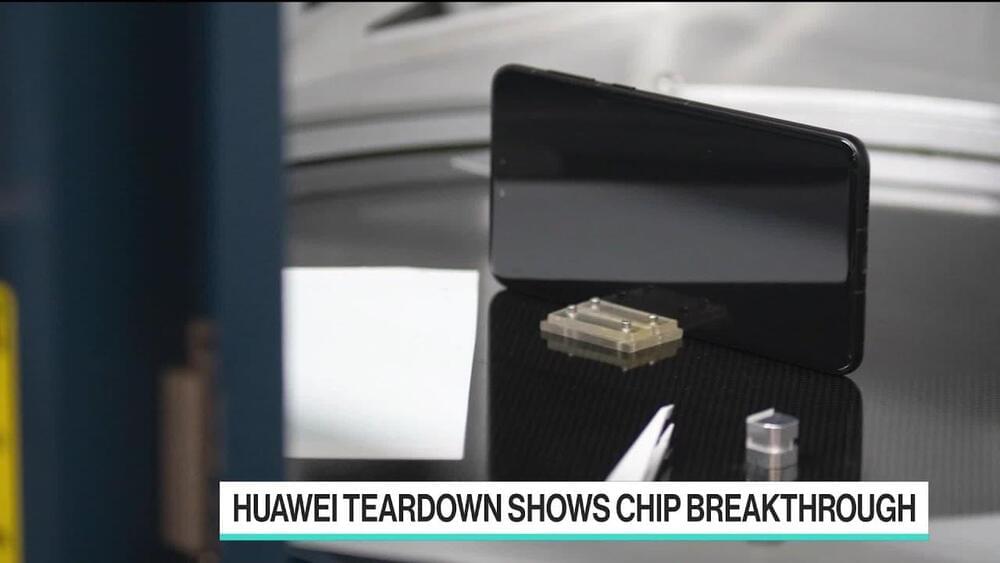Sep 6, 2023
Intel Demos 8-Core, 528-Thread PIUMA Chip with 1 TB/s Silicon Photonics
Posted by Dan Breeden in category: computing
Intel demoed a non-x86 chip with eight cores, 528 threads, and 1TB/s of optical I/O at Hot Chips 2023.
Intel demoed a non-x86 chip with eight cores, 528 threads, and 1TB/s of optical I/O at Hot Chips 2023.

Huawei and China’s top chipmaker have built an advanced 7-nanometer processor to power its latest smartphone, a sign Beijing is making early progress in a nationwide push to circumvent US efforts to contain its ascent. Peter Elstrom reports on Bloomberg Television.
——-
Follow Bloomberg for business news & analysis, up-to-the-minute market data, features, profiles and more: http://www.bloomberg.com.
Connect with us on… Twitter: https://twitter.com/business Facebook: https://www.facebook.com/bloombergbus… https://www.instagram.com/bloombergbu…
Twitter: https://twitter.com/business.
Facebook: https://www.facebook.com/bloombergbusiness.
Instagram: https://www.instagram.com/bloombergbusiness/

Scientists have been able to observe a common interaction in quantum chemistry for the first time, by using a quantum computer to shadow the process at a speed 100 billion times slower than normal.
Known as a conical intersection, the interactions have long been known about, but are usually over in mere femtoseconds – quadrillionths of a second – making direct observations impossible to carry out.
Scientists from the University of Sydney and Fudan University have found human brain signals traveling across the outer layer of neural tissue that naturally arrange themselves to resemble swirling spirals.
Published in the journal Nature Human Behaviour, the study suggests that these widespread spiral patterns, seen during both rest and cognitive activity, play a role in organizing brain function and cognitive processes.
Senior author Associate Professor Pulin Gong, from the School of Physics in the Faculty of Science, said the discovery could have the potential to advance powerful computing machines inspired by the intricate workings of the human brain.
Scientists have been left baffled by the discovery of the wreck of a 2,000-year-old “computer” that is amazingly complex.
The Antikythera mechanism – an astronomical calendar – has been dubbed “‘the first computer” and has baffled scientists for generations after it was first discovered inside a Greek shipwreck in 1901.
The device is a hand-powered time-keeping instrument that used a wing-up system to track the sun, moon and planets’ celestial time. It also worked as a calendar, tracking the phases of the Moon and the timing of eclipses.
Apple’s own System on Chips (SoC) designs used in iPhones, iPads and now Macs (with ‘Apple Silicon’ branding) are a key source of competitive advantage for the Cupertino giant. The Arm instruction set compatible, but Apple designed, processors used in these SoCs, consistently outperform competitors’ designs.
Apple is the modern exemplar of the maxim from Herman Hauser, founder of Acorn, Apple’s partner in the original Arm joint venture, that ‘there will be two types of computer company in the future, those with silicon design capability and those that are dead ’.
But Apple’s first attempt to design its own processor came over twenty years before the appearance of the first iPhone. We’ve seen in the RISC Wars Part 1: the Cambrian Explosion how, as the 1980s progressed, almost every semiconductor manufacturer and computer maker felt the need to have their own processor design. Apple was no exception.
Researchers have developed a way to address many quantum dots with only a few control lines using a chessboard-like method. This enabled the operation of the largest gate-defined quantum dot system ever. Their result is an important step in the development of scalable quantum systems for practical quantum technology.
Quantum dots can be used to hold qubits, the foundational building blocks of a quantum computer. Currently, each qubit requires its own addressing line and dedicated control electronics. This is highly impractical and in stark contrast with today’s computer technology, where billions of transistors are operated with only a few thousand lines.
A new nanoscience study led by a researcher at the Department of Energy’s Oak Ridge National Laboratory takes a big-picture look at how scientists study materials at the smallest scales.
The paper, published in Science Advances, reviews leading work in subsurface nanometrology, the science of internal measurement at the nanoscale level, and suggests quantum sensing could become the foundation for the field’s next era of discoveries. Potential applications could range from mapping intracellular structures for targeted drug delivery to characterizing quantum materials and nanostructures for the advancement of quantum computing.
“Our goal was to define the state of the art and to consider what’s been done and where we need to go,” said Ali Passian, an ORNL senior research scientist and senior author of the study.

We are about to leap into the age of quantum computing and possibly our technological capabilities will evolve rapidly as a result.
Does this mean we are on the threshold of developing a Type 2 civilization?
If so, we should soon be able to make first contact with other intelligent life forms and slowly conquer space.
Continue reading “Why We Can Never Find a Type-7 Civilization!” »
Going from 49kB of transient program area to 60kB took only a single NAND chip, in this interesting experiment in vintage bank-switching.